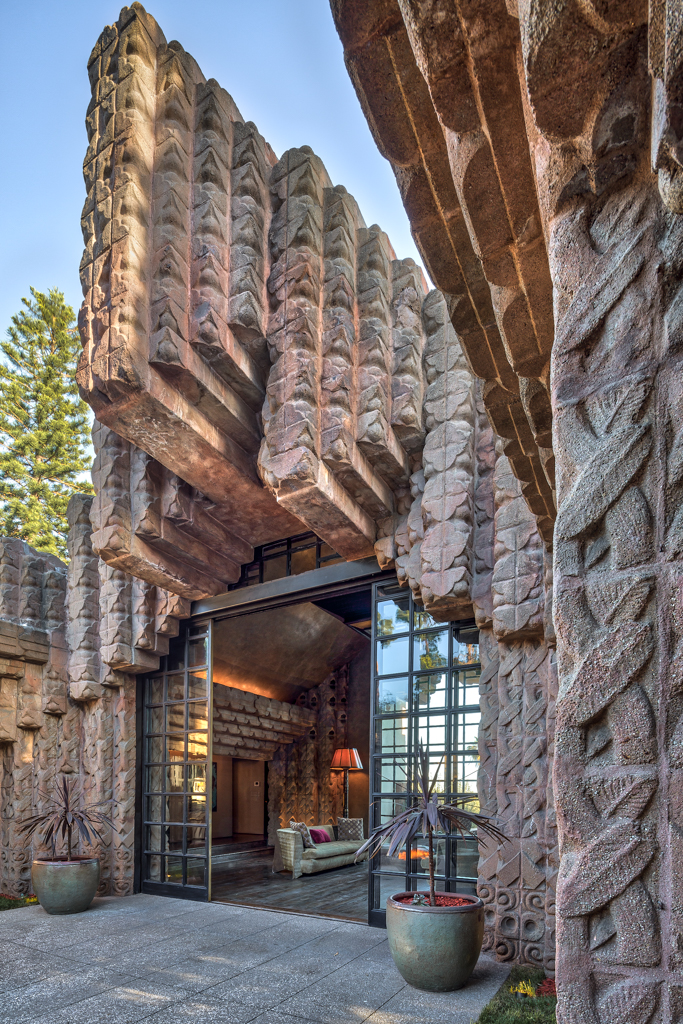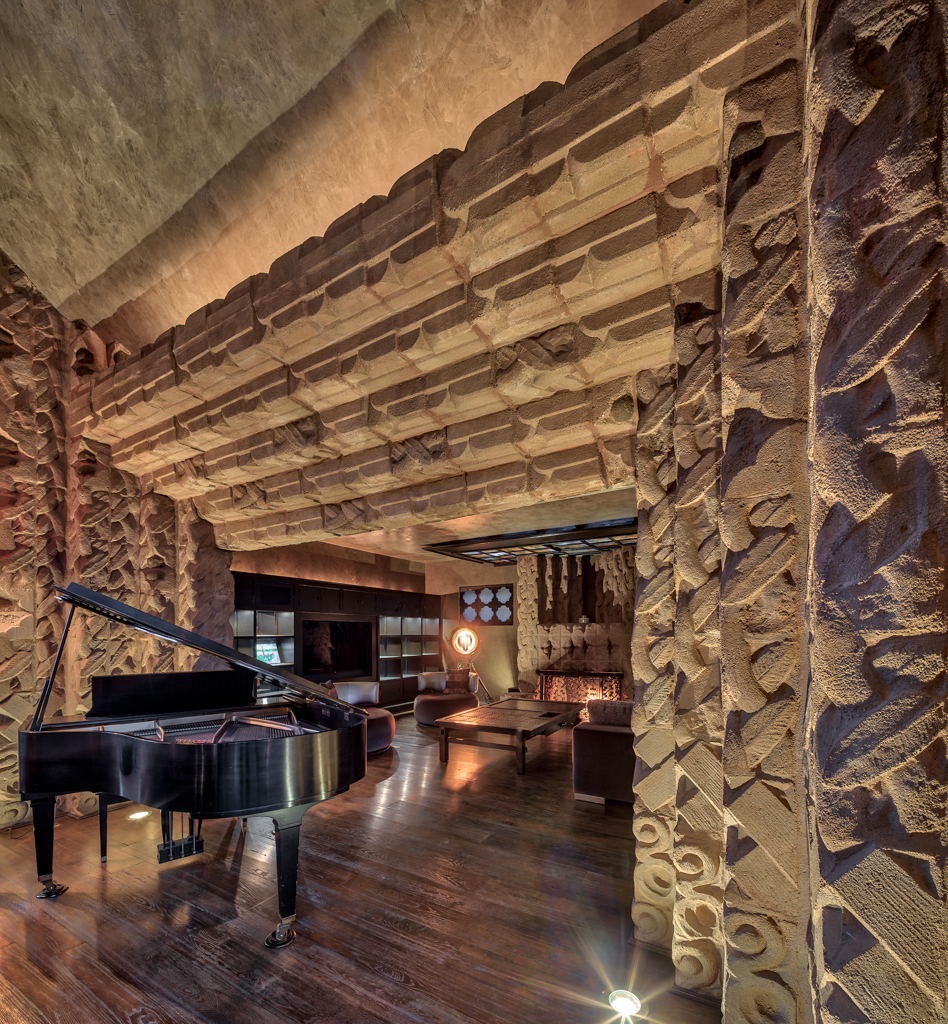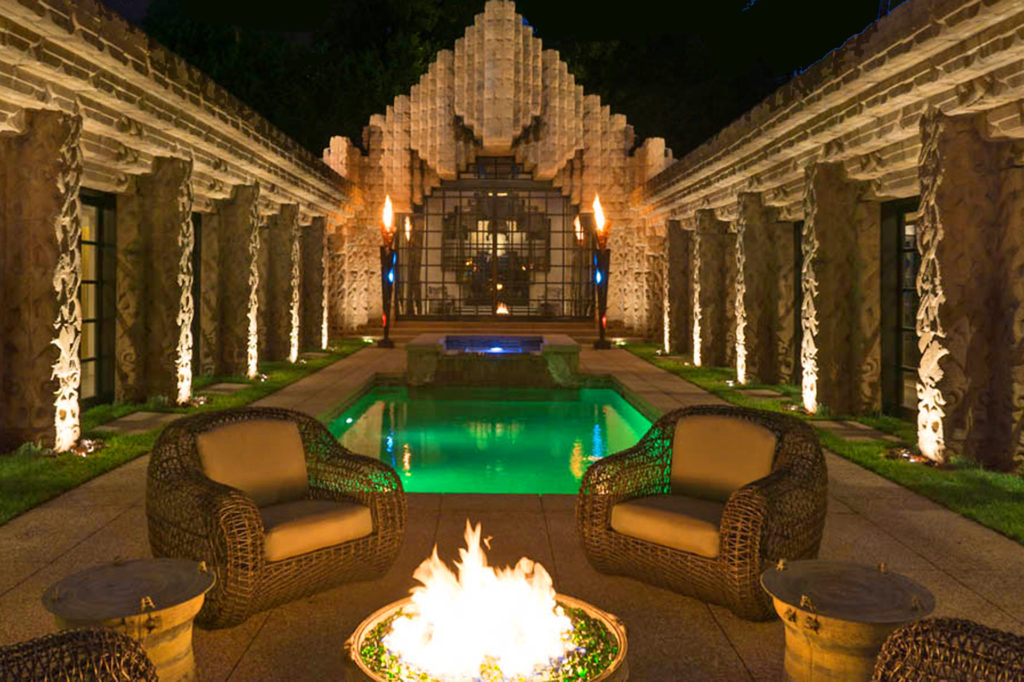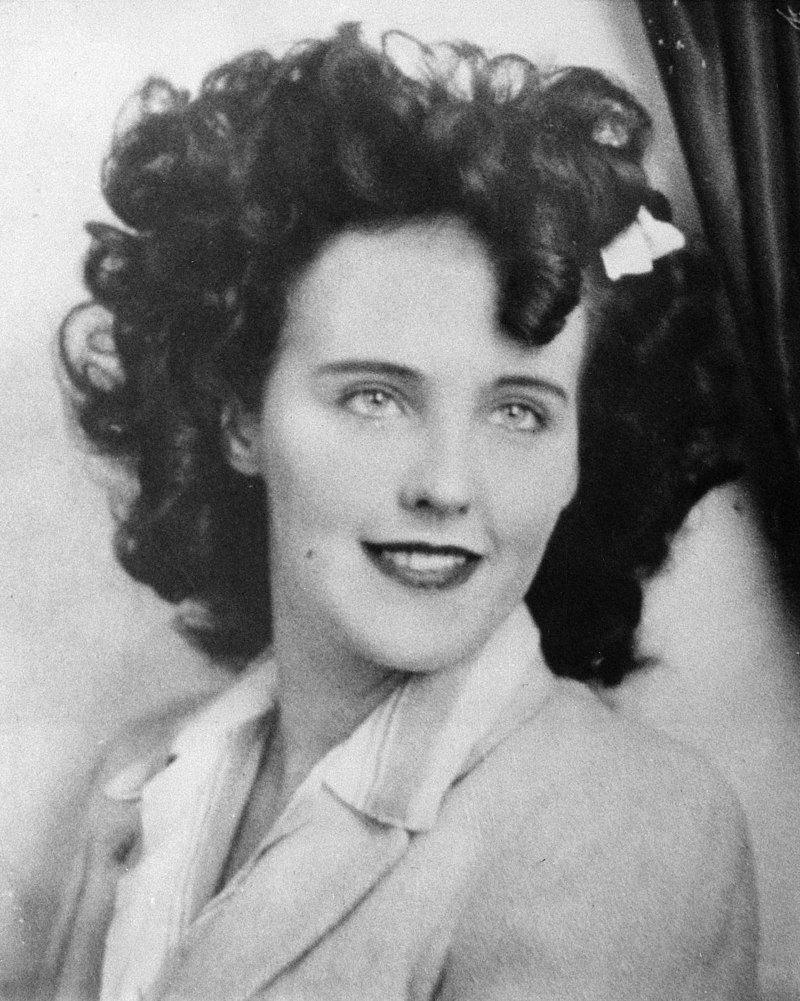Los Angeles is like an architectural exquisite corpse game, where a Victorian Queen Anne can stand proudly beside a kitschy Craftsman facing a rustic Mission Revival home across the street. There’s little rhyme or reason other than a seemingly ever-present row of towering palm trees tying everything together. Unsurprisingly, Los Angeles boasts some of the boldest architectural feats in the country, encompassing commercial and residential real estate alike in creativity. But today, we’re taking a closer look at an LA home that may not be the most famous but is certainly among the most infamous. Hop in the car; we’re going to Los Feliz!
Welcome to the Sowden House
Franklin Avenue is one of the busiest stretches of road cutting through the tranquil neighborhood of Los Feliz. It serves as an east-west thoroughfare to Hollywood, keeping traffic predictably steady despite mostly bisecting residential areas. Like the rest of the city, it’s a homogeneous mix of architectural styles. Yet, one home is instantly distinguished by its dark sense of mystery and striking design. Between the corners where Normandie and Winona connect with Franklin, you’ll find the Sowden House.
Some immediately recognize its structural influence with obvious inspiration from ancient Mayan pyramids. Others simply see the ever-hungry maw of an enormous shark gaping threateningly at passing motorists. And if the stories are to be believed, at least one life has vanished down the Sowden House’s cavernous throat. But its story begins auspiciously enough in the midst of roaring ‘20s excess.
An LA Home That Embodies the Arts
John Sowden, an eccentric photographer and purveyor of the arts, commissioned his friend Lloyd Wright, a set designer for Paramount, to construct the Sowden House. If that name sounds familiar, it’s because Lloyd Wright was the oldest son of world-renowned American architect Frank Lloyd Wright. As the Sowden House illustrates, he learned quite a bit from his father. With Sowden’s colorful tastes, Wright was no doubt encouraged to plan the strangest LA home possible. He didn’t hold back.
Completed in 1926, the Sowden House was every bit as striking then as it is now, though not nearly as revered. Wright employed the use of concrete blocks to create the otherworldly Mayan pyramid that crowns the LA home. While this technique may seem exotic by today’s standards, it was simply regarded as an obvious cost-cutting measure in the decadent ‘20s. Perhaps this was a factor in John Sowden’s hasty departure. Despite highly anticipating the property as his own personal entertainment hub for his Hollywood Hill artist friends, Sowden sold the property in 1930.
The Floor Plan of the Sowden House
Upon construction, Wright’s Sowden House utilized an open floor plan with the home’s central courtyard serving as an axis facilitating a flow between the radius rooms. As we mentioned, the famed architect’s use of concrete blocks was heavily criticized at the time for their affordability. Yet, these earth-toned blocks were crucial in realizing his exotic vision. Wright believed in landscape architecture, exhibiting a particular reverence for nature. This was paid tribute with images of water, clouds, the sun, and harvest activities inscribed into the concrete, giving the LA home a ritualistic quality.
The façade offers the characteristic Mayan pyramid design. Meanwhile, the courtyard exhibits pillars reminiscent of specific ancient Mayan temples like Uxmal and Sayil. Intricate copper gates bar the entry which then leads upward through a dark, cavernous stairway into the home. Adopting a rectangular structure, the rooms circle the aforementioned courtyard. Arguably the most renovated area, the courtyard is almost unrecognizable from its original design today. At one time, the courtyard was home to both a pool measuring 32-feet long as well as a decorative fountain. IIt once featured a pair of concrete block water organs but an earthquake leveled them. The pool and fountain were eventually removed in favor of a lawn where guests were encouraged to lounge during theatrical and musical performances.
The 2001 Renovations
The Sowden House underwent a major renovation when designer Xorin Balbes purchased the property for 1.2-million dollars in 2001. At the time, he deemed the once mysterious and majestic LA home “a wreck” and invested 1.6-million dollars in its renovation. Much of the cost went to revitalizing the heavily eroded concrete blocks and converting a three-section kitchen into one much larger open space kitchen. In addition, Balbes overhauled the bathrooms and reinstalled a pool in the central courtyard along with a spa.
Wright’s son, Eric Lloyd Wright, criticized Balbes’ commissioned renovations. Historical preservationists likewise expressed disappointment at news of the changes. Major criticisms focused on the changes to the courtyard area, the entryway staircase, and Asian accents that clashed with the pre-existing Mayan theme. But with the costly updates came new attention on a property that had largely gone ignored over the decades. Following renovations, the Sowden House appeared in commercials and popular films such as L.A. Confidential and The Aviator. It also became a hot spot for corporate retreats, celebrity fundraisers, and high scale weddings.
A Potentially Horrifying Past
The Sowden House has exchanged ownership numerous times over the years. Despite the Hollywood debauchery linked to the LA home, there’s a single resident who has drawn more attention to the Sowden House than any other. And the accusations pitted against this resident from his very own son paint the Sowden House as the site of one of the city’s most grisly and notorious murders.
The decadence and depravity of Hollywood was like a beacon to noted physician Dr. George Hodel. His razor sharp intelligence and status as a musical prodigy contributed to his instant charisma. But he also harbored a sordid history of sexual scandal and abuse allegations. It followed him to the Sowden House, when he purchased it in 1945. It was less than two years later when he allegedly murdered aspiring Hollywood starlet Elizabeth Short. The cold surgical precision of the crime continues to horrify to this day.
A Mystery Stretched Across Time
According to Hodel’s son, a retired homicide detective, the doctor had committed the atrocity, along with several other murders, in the basement of the Sowden House. Short’s murder became popularly known as the Black Dahlia Murder, one of the most notorious crimes in American history. But before charges could be brought against Hodel, he abandoned his family, fleeing to Asia in 1950.
It’s still unclear whether Hodel actually committed the murders. Yet his son, Steve Hodel, published a book about his theory in 2003 entitled Black Dahlia Avenger. In 2013, he returned to his childhood home with police canines who allegedly found trace human remains in the Sowden House basement. Were the remains Short’s? Unfortunately, that mystery continues. But with legends trumping confirmed truths, public consensus agrees that this is the site of the notorious murder. Hollywood area tours often stop outside of the LA home to regale tourists with the tale. You’ll also regularly find independent locals stopping to snap photos of the windowless facade facing Franklin Avenue. In the shadow of such a grotesque story, the hungry, gaping “jaws” of the pyramid structure are hard to ignore.
A Greener Present for the Sowden House
But even one of the world’s most infamous unsolved murders isn’t enough to scare people away from a home this majestic. The most recent owner of the Sowden House purchased the LA home in 2018 for 4,795,000-dollars with plans to make it, among other things, a fertile meeting spot for the rising stars in cannabis culture. Dan Goldfarb, founder of the pet CBD brand Canna-Pet and a former hedge fund analyst, has already continued the property’s lively spirit. Since Goldfarb’s acquisition of the residence, it’s been the venue for a political fundraiser, music video, art exhibition, performance art experience, and more.
While Lloyd Wright initially endured a wave of criticism for the Sowden House, the response softened over his lifetime. When he passed away in 1978, the Los Angeles Times heralded the home as the masterpiece of his residential designs. Wright’s son, Eric, even offered compliments on some of the renovations. While he enjoyed the revised kitchen and masterful landscaping design, he still found the courtyard changes unimpressive. Lloyd Wright would use the Mayan-influence again when designing a short-lived wooden shell for the Hollywood Bowl. However, it was the last time any member of the Wright family would employ this unique design style. The Sowden House continues to contribute to the Wright’s lasting legacy of innovation with a place on the U.S. National Register of Historic Places.
Get the Story of Our Other Home Spotlights in Los Angeles, Palm Springs, Las Vegas and More
The Bob Hope House
The Chemosphere
The Spadena House
The Underground House
The Lonnie Hammargren House
The Most Expensive Mansion in the Coachella Valley
The Sam Maloof House
The Invisible House & Mirage House
Casa de Shenandoah
The O’Neill House
The Elrod House
Hartland Mansion
Dawnridge
The Mosaic Tile House
The Lummis House
The Upton Sinclair House
With a brand that says as much as JohnHart’s, Senior Copywriter Seth Styles never finds himself at a loss for words. Responsible for maintaining the voice of the company, he spends each day drafting marketing materials, blogs, bios, and agent resources that speak from the company’s collective mind and Hart… errr, heart.
Having spent over a decade in creative roles across a variety of industries, Seth brings with him vast experience in SEO practices, digital marketing, and all manner of professional writing with particular strength in blogging, content creation, and brand building. Gratitude, passion, and sincerity remain core tenets of his unwavering work ethic. The landscape of the industry changes daily, paralleling JohnHart’s efforts to {re}define real estate, but Seth works to maintain the company’s consistent message while offering both agents and clients a new echelon of service.
When not preserving the JohnHart essence in stirring copy, Seth puts his efforts into writing and illustrating an ongoing series entitled The Death of Romance. In addition, he adores spending quality time with his girlfriend and Romeo (his long-haired chihuahua mix), watching ‘70s and ‘80s horror movies, and reading (with a particular penchant for Victorian horror novels and authors Yukio Mishima and Bret Easton Ellis). He also occasionally records music as the vocalist and songwriter for his glam rock band, Peppermint Pumpkin.







